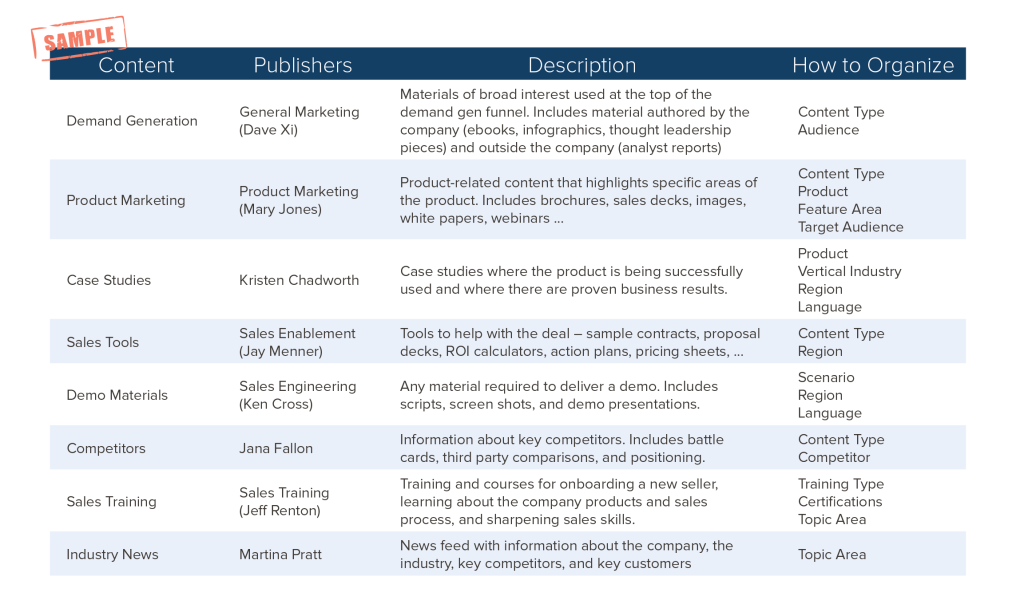If you’re like me, before you go on a trip to a place you’ve never been before, you take some time to look over a map of the area—either on paper or on your phone. I like to know the major roadways, potential construction zones or slowdowns, and the general direction I need to head to get where I’m going. In a lot of ways, deploying a Sales Enablement solution is like taking a trip to a place you’ve never been before. Instead of mapping highways and byways, it’s a good idea to map out your organization’s content before you take the trip.
We work with our customers to build a content map as one of the first steps in the implementation process. I thought it would be helpful to share a little insight around what a content map looks like, how to create one, and how it fits into the Sales Enablement design process.
What’s a content map?
It sounds a little more complex than it actually is. A content map is a spreadsheet that categorizes your content, based on various groupings that make it easy to organize and find. These groupings include categories like content type, use case, who is responsible for publishing it, and how to organize it in the Sales Enablement Platform.
First, identify stakeholders
Before you begin, it’s important to identify the stakeholders that have a role in your organization’s content strategy. These should be the people that publish content, organize it for the sales team, or analyze its performance. Publishers are often in the marketing team, but other parts of the company also produce content that is necessary during a deal – perhaps documentation about the sales process your company uses, or training and readiness material.
Second, map content.
It’s important to focus initially on the content that’s most important rather than trying to capture every possible thing a seller might need. Resist the urge to make all your content perfect before launch—it will just derail and delay your launch. Simply giving the sales team a well-organized and intuitive way to find the content is usually a huge leap forward in helping them be effective. Content is never “done,” so just let it evolve—Get the most important content into a Sales Enablement solution, organize it well and let the technology help you analyze content gaps and needs.
The best way to organize the content you need to bring online into your Sales Enablement platform is to create a content map. As a general rule, you want to organize content by type or use case—for example, product marketing, case studies, sales tools, etc. Then, if possible, assign a single publisher own “publishing” each type of content—this keeps the number of people in charge of content to a manageable number.
In the example below, you’ll see that the company has divided content into eight types and then provided a publisher, description, and the categories with which they want to organize the content in their sales enablement platform. Notice these are relatively broad buckets to keep it manageable. Content within each bucket can be further refined through filters on categories (audience, product, feature area, industry, etc.)

Best practices for categorizing content
Just like every snowflake is different, every organization’s content needs are different. No two companies organize content exactly the same way, but we’ve found that these best practices can help simplify the process of creating your content map.
- Keep it to 8-12 categories, no more. Make sure they apply to the most common scenarios. No need to create a category for every possible permutation of a content scenario, as that will just get cumbersome and confusing.
- Sales comes first. Making it easy for the sales team to find content is the #1 goal. Check your mapping with sales to make sure the categories work optimally for them. Marketers often think about content differently from sellers. Prioritize first for the mainstream sellers, then think about other specialized user groups.
- Content groups should be intuitively obvious for reps and publishers to understand. Think about how someone would be likely search for a piece of content. Make your categorization as obvious and unambiguous as possible, and keep it high level. The great majority of your content should fit obviously into a single top-level category.
- Keep it simple, keep it small. Try to limit the number of publishers per content type. This helps with consistent organization and reliable results.
With your content mapped, you’re ready to take advantage of a Sales Enablement platform, which you can learn more about in the Definitive Guide to Sales Enablement tools and software chapter.
Want more hands-on help with a content map?
Creating a content map is a relatively simple process – you can get a first draft done in a couple of hours. We’ve helped hundreds of companies complete this exercise as part of the Highspot onboarding process, and have started teaching a workshop aimed at helping organizations build it out for themselves. We’ve been hosting complimentary workshops in Seattle, San Francisco, and Boston. But we’ll be scheduling more for the fall. Keep tuned to our events page for upcoming dates.



